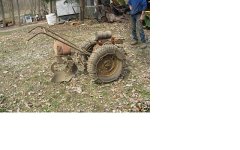SPYDERLK
Super Star Member
- Joined
- Feb 28, 2006
- Messages
- 12,525
- Location
- VA
- Tractor
- JD2010, Kubota3450,2550, Mahindra 7520 w FEL w Skid Steer QC w/Tilt Tatch, & BH, BX1500
Note that the description is regarding ground engaging implements. All of their resistance to motion is at or below ground level. So yes in that instance the front end is pushed down. The distance below ground the force is applied times the force applied by the tires at ground level is the net torque trying to rotate the tractor forward [front tip]. If the resisting force is at ground level there is no net torque. If above ground there is net torque trying to back tip the tractor. In each case these torques are proportional to the vertical distance from the level at which the tractor exerts horizontal force to the level at which the load exerts horizontal force.Second: It MAY be not be true for all tractors, and for all geometries, but some tractors can pull down on the front end. If you look at the details of the "Ferguson system," when it was introduced, they made that claim.
Many older tractors had a tremendous coil spring behind the bracket that the top hitch attached to. That spring had to be compressed to get draught control (up) action. If you look at the geometry of the situation, it would appear that tractor can apply down pressure on the front end in some cases.
I will dare say that any tractor pulling a three point hitch load where the pulling force is more than the weight of the implement, it will create a down force on the front end. The attachment points of the lift arm are below the axle level, therefore that creates down force (under the circumstances I described.) Also, the top link is well above the axle, therefore that will also create down force on the front end. Bear in mind, that even if the front end comes up off the ground, this is STILL true because the front end would have come up earlier and further than if it had not had the system.
In the words of my logic professor "Now, go home and convince yourself this is true."
Yesterday's Tractors - Ferguson System Principal and Theory of Operation
larry

